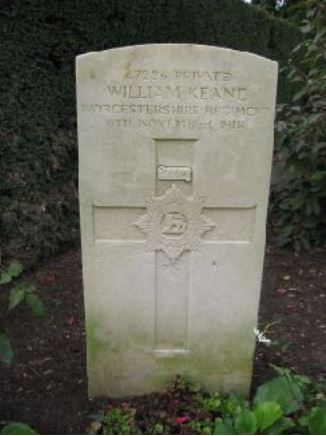15th Battalion, Worcestershire Regiment

William Barclay Keane was born in St James Parish, Dublin in October 1893, a son of Patrick and Kate Keane. He had one sister. He lived nearby in Kilkenny and was a labourer before entering the Army on 20 September 1913 at the age of 19. Prior to this he had served in the Reserve with the Leinster Regiment for about a year.
On 20 September 1913 he signed attestation papers to serve for five years with the Colours and seven in the Reserve and was accepted as fit for the Army and joined Princes Victoria’s Royal Irish Fusiliers (RIF) (motto Faugh-a-Ballaghs – Clear the Way) and was given the number 11357. At his medical he was 5 feet 3.7 inches tall, 121 pounds in weight and had blue eyes and brown hair. His declared religion was Roman Catholic.
He was posted to the 1st Battalion, RIF at Moore Barracks, Shorncliffe, Kent on 25 September 1913 and served there until 21 August 1914.
At the outbreak of the War the 1st Battalion was part of 10 Brigade, 4th Division and the battalion arrived in France on 22 August 1914 and first saw action four days later at the Battle of Le Cateau, where the British Expeditionary Force (BEF) made a stand during what was known as ‘The Retreat from Mons’.
Private Keane’s Pension Record has survived at the National Archives and this provides a lot of detail as to his movements in the Great War.
Having arrived in France on 22 August 1914 his stay there was only until 15 January 1915. For reasons which are unclear he returned to the Regimental Depot the following day and stayed there until 26 July 1915. He returned to the Western Front on 27 July 1915, remaining there until 1 September 1915.
At a medical board in the autumn of 1917 Private Keane claimed that he was gassed at Dickebush (Ypres Salient) on 21 April 1915. However, this was one day before the Germans first used poison gas on the battlefield and in another statement he stated he was gassed in June and spent one week at the Duchess of Westminster’s Hospital at Calais before repatriation to a hospital at Bury St Edmonds, where he spent nine weeks, suffering breathing difficulties. His record shows he was posted back to the UK for the period 2 September 1915 until 13 March 1916.
He transferred to 6th Battalion, RIF and on the 14 March 1916 landed at Salonika, as part of a re-enforcement draft, joining his unit in the field on 5 April. On 13 April he sought treatment at a field ambulance for bronchitis and on 6 May 1916 he was admitted to St George’s Hospital, Malta, prior to being sent back to England on 19 June. He was admitted to the Second Western General Hospital, Manchester, suffering from bronchitis, on 26 June 1916 and remained there until 12 July 1916. He returned to Salonika on 27 August 1916 but was admitted to hospital one month later (on 28 September), again with bronchitis and was transferred to St Patrick’s Hospital, Malta on 9 October before being repatriated to England on 13 December 1916.
Having arrived back in the UK, he was no longer considered fit for front line service and was posted to the newly formed 15th (Transport Workers) Battalion of the Worcestershire Regiment, who, under the command of Captain (Temporary Lieutenant-Colonel) P A Hopkins was located at Swindon and employed on transport duties in the south of England. He was given the number 47226.
During his stay in Swindon he married Edith Anna Apperley on 17 May 1917.
Another period of hospital internment followed, at University War Hospital, Southampton between 22 June and 4 July 1917; once again bronchitis was the cause. On 23 October 1917 he went before a medical board at Southampton who declared that he was suffering from ‘bronchitis (chronic), catarrhal’, which was deemed to relate to his being gassed in 1915. He was assessed as having 40% disablement and to be permanently unfit for war service and was discharged from the Army on 22 November 1917. He received a Silver War Badge (SWB) to signify his discharge from the Services.
How or why he came to Gloucester is not known but the BMD records show he died there on 6 November 1918 (cause unknown), age 24 and was buried in Gloucester Old Cemetery, where a standard CWGC headstone marks his grave.
There is a Medal Index Card for 11357 Private William Kane, which also shows his Worcestershire Regiment number (47226) and this only shows entitlement to the 1914 Star. There is, however, also a card for 47226 Private William Keane, shown as being in the Worcestershire Regiment and entitled to the SWB.
His 1914 Star (Mons Star) was part of a lot from Whyte’s Auctions, Dublin on 13 November 2010 – other items an Irish Shooting Medal, an old envelope, a school patch and soldier’s made decorative chain. The Mons star was engraved ‘11357 Pte W Kane R.IR;Fus’
Researched by Graham Adams 12 February 2016 (revised)
(Some of the information here was supplied by an Irish correspondent — name lost)
